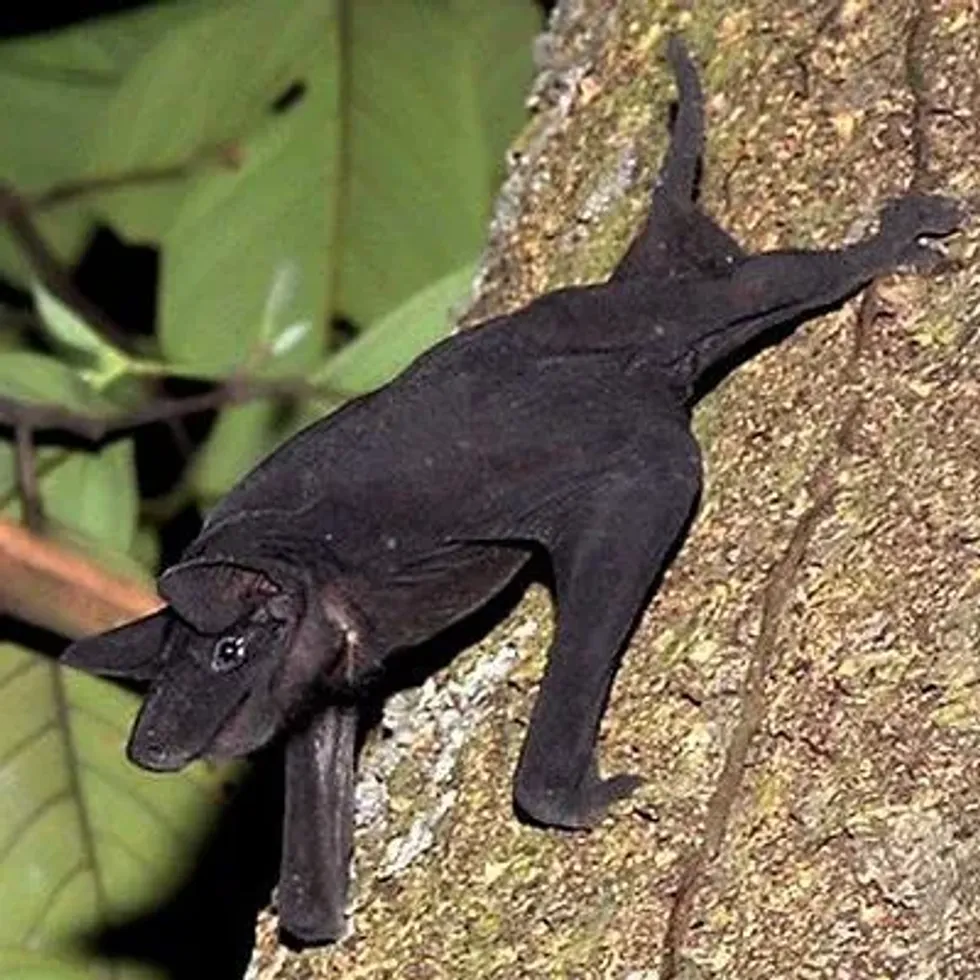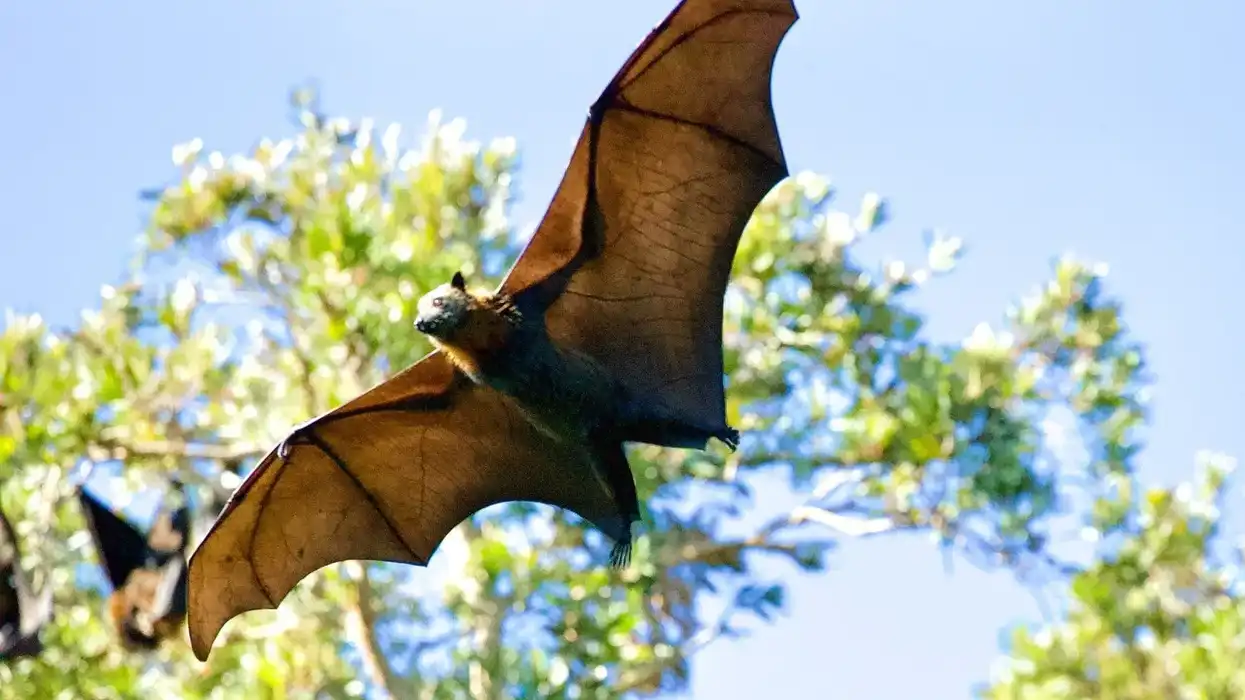The hairless bat or Naked Bulldog bat (Cheiromeles torquatus) is a species of free-tailed bats that is native to southeast Asia. They belong to the family Molossidae and are found in places such as Thailand, the Philippines, Borneo, Singapore, and Sumatra; and usually inhabit caves and other crevices.
This species of free-tailed bats are largely insectivorous and leaves the roost early in the morning to find prey. They are characterized and named after their hairless bodies and their bulldog-like appearance. There are a few patches on their bodies such as the first toe on their hind foot and their throat, where there are tiny fine hairs.
This species comes into the list of threatened species as one of Least Concern, which means that their habitat and lifespan face no immediate threat. However, habitat loss has caused them to relocate over the few years.
If you enjoy reading about bats and think they are fascinating, make sure to check out the hoary bat and red bat here at Kidadl.
Hairless Bat Interesting Facts
What type of animal is a hairless bat?
The hairless bat (Cheiromeles torquatus), like the name suggests, is a bat! It is also known by common names such as the great naked bulldog bat or the great naked bat, and belongs to the family of free-tailed bats.
How many hairless bats are there in the world?
There is no conclusive study as to how many hairless bats there are in the world, but their conservation status suggests that their population size is fairly large, and faces no immediate threat.
Where does a hairless bat live?
The hairless bat, like other free-tailed bats, prefers caves and crevices in trees. They roost with more of their own kind and prefer dark and damp areas.
What is a hairless bat's habitat?
These species of bats are usually found in parts of southeast Asia such as Malaysia, Borneo, Thailand, Singapore, Sumatra, islands surrounding the Philippines, and so on.
Who do hairless bats live with?
The naked bulldog bat (Cheiromeles torquatus) is a typically colonial species, which means that they prefer to live with more of their own kind. This free-tailed bat roosts in large colonies and can be seen to be in distress when in isolation.
How long does a hairless bat live?
There are no studies regarding the range of the lifespan of hairless bats, however, the average bat lives for up to 20 years!
How do they reproduce?
These bats are mammals, which means that the female hairless bat gives birth to the offspring in the same way that humans do. The average female only gives birth to two off-springs each year, one in each gestational cycle.
Hairless bats are not particularly involved in the rearing of their off-springs. The female can be seen to leave its babies in the roost each morning, even when they are only a day or two old. The male, on the other hand, remains completely detached from the process of rearing babies.
What is their conservation status?
The conservation status of the hairless bats is declared to be of Least Concern by the IUCN. This means that the species faces no immediate or irreversible threat of extinction in the near future.
However, there has been a certain decline in their population due to various factors such as the loss of their habitat and hunting.
The loss of habitat disperses one or a few of the individuals, resulting in isolation. On the other hand, hairless bats are hunted and killed in large numbers for consumption in Southeast Asia.
Hairless Bat Fun Facts
What do hairless bats look like
A lot can be understood regarding the physical appearance of this species from its common names. As the names greater naked bat, hairless bulldog bat, free-tailed bat, and hairless bat suggest, this species is largely hairless, except for a few isolated spots wherein one might find patches of short, bristle-like hair!
These hairy patches occur on their throat and on the first toe of their hind foot.
They also have a few hairs on the head. The 'bulldog' part of their name comes from their head, which is somehow reminiscent of a bulldog!
Apart from this, they are usually of black or dark grey color and are characterized by their wrinkly skin. They also have pockets on either side of their body, where they can tuck their wings in the night in order to sleep. These features are typical of every animal in the family Molossidae.

*Please note, this is an image of the short-tailed bat, and not a hairless bat. If you have an image of the hairless bat, please let us know at hello@kidadl.com.
How cute are they?
Well, you might have different opinions, but the wrinkly skin, localized bristly hairs around their throat and hind foot and, bulldog head do not really come of as very cute to us!
How do they communicate?
Hairless bats have a very curious way of communicating. They secrete a chemical from the hairy patch on their throats, which the others of the same species can decipher. This free-tailed bat can also communicate through touch or feeling.
How big is a hairless bat?
The hairless bat is a species that is comparatively larger. Its length can range from 4.53-5.71 in (11.5-14.5 cm). This species is about half the size of the Mexican free-tailed bat!
How fast can a hairless bat move?
Although the exact range of speed of the family Molossidae as a whole is not known, it is understood that bats are fair flyers. It can also be assumed that the sleek wings of the hairless bats allows them to fly at great speeds!
How much does a hairless bat weigh?
The average hairless bat can weigh about 0.36-0.43 lb (167-196 g).
What are the male and female names of the species?
The male and female hairless bats do not have any specific names. We would simply have to refer to them as the male hairless bat and the female hairless bat.
What would you call a baby hairless bat?
Hairless bat off-springs, like in the case of other bats, would be called pups!
What do they eat?
The hairless bat mainly consumes insects such as termites and click beetles. They usually leave their roost early in the morning to find prey at sites such as lowlands.
Are they aggressive?
There is no evidence that this species would be of any harm to humans. They are also colonial in nature, which means that they hardly have any disagreements within their own community. It is, therefore, safe to assume that they are not aggressive in nature.
Would they make a good pet?
It is unlikely that the hairless bat would make a good pet because they are pretty difficult to take care of. Bats, in general, are hardly domesticated since it is tough to replicate their habitat.
Did you know...
Male hairless bats do not participate in the rearing of their pups. Even females leave their roost early each morning for their daily routine.
Hairless bat can be observed to follow a very keen routine in the morning. Every morning, the entire colony leaves their cave or crevice of choice to find prey such as termites and moths.
Bats have a lot of predators and are generally killed by hawks, owls, and snakes.
Bats generally excrete through their mouth.
Are hairless bats clean?
Bats are similar to cats when it comes to cleanliness. They are self-grooming and very hygienic. hairless bats, too, have a flat nail in one of their toes which helps them to clean and groom themselves. They don't bathe as such, but lick themselves to groom them.
Behavior of the hairless bat
This species of bats are colonial and roost in large groups. A large number of bats inhabit the same cave or rock crevice. They are also migratory and nocturnal, which remains constant through the entire class of bats.
Here at Kidadl, we have carefully created lots of interesting family-friendly animal facts for everyone to discover! For more relatable content, check out these ghost bat facts or fruit bat facts pages.
You can even occupy yourself at home by coloring in one of our free printable Hairless bat coloring pages.










